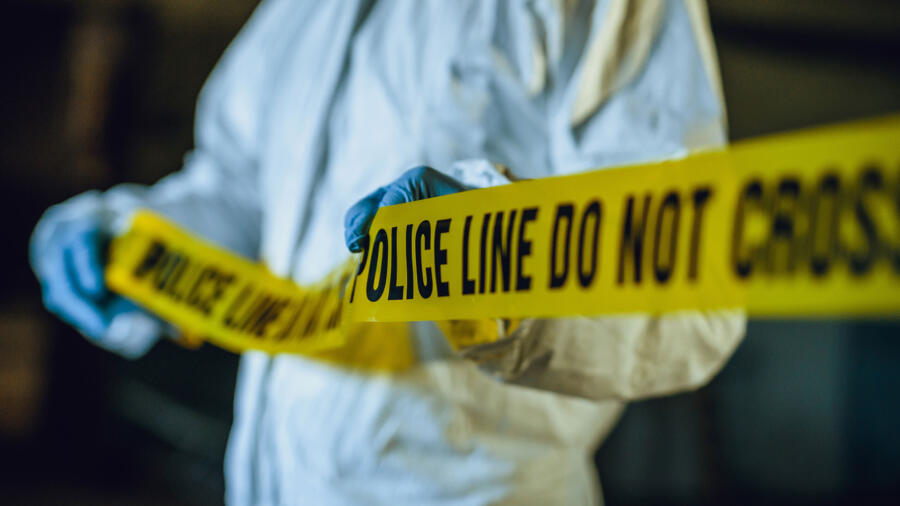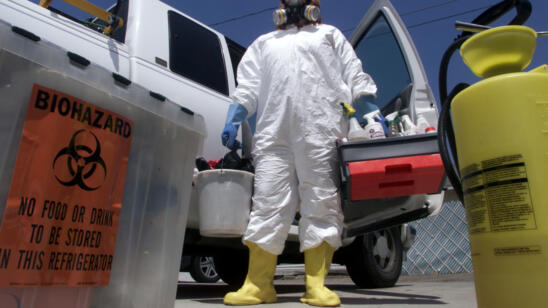Ken Holmes spent four decades working in the Marin County Coroner’s Office, just north of San Francisco, California. Throughout his time as both a death investigator and eventually a coroner, he’s uncovered many mysteries around suspicious deaths.
Holmes talks to A&E True Crime about the small clues that have helped solve big crimes and the surprising aspects of dealing with death for a living.
You started out as a death investigator and ended up as a coroner. What is the difference?
As a death investigator, I was on the street going to death scenes on a 24-hour shift. Anytime someone dies—a house fire, a car crash, suicide, natural causes or suspicious ones—the death investigator is immediately called to the scene. We examine the body, talk to witnesses and determine the rough time of death from lividity (blood settling in the body after death), rigor mortis or temperature. There’s a whole routine of photos and measurements we go through. We identify firearms and casings, and legal and illegal drugs. We count every pill in every bottle at a death scene to determine if the person has taken meds.
The coroner signs off on the cause of death. Probably one of biggest surprises is that coroners are not required to have any medical training. (One county in Indiana elected a high school student coroner.) Coroners do have to complete the same training police officers do.
When I became assistant coroner, I moved into the administrative world and supervised the investigators. If a case was very extraordinary or likely to bring in a lot of media, I would come out to the scene and be a spokesperson.
Is a coroner the same as a medical examiner (ME)?
The function is the same, but politically they are different. The coroner is elected, the ME is appointed—usually by the local board of supervisors or other governing body. MEs are licensed physicians and usually have training in forensic pathology. (They do autopsies when needed, not coroners.) Both of their reason for being is death investigation and the protection and preservation of assets of a decedent up until time they can be released to the next of kin.
When you show up at a death scene and then investigate it, are you working side-by-side with police detectives?
We do exactly the same thing from a different standpoint. We are right there with detectives or the police department or whatever agency is involved. Their main focus is: ‘Who did it—how and when?’ The coroner or ME asks, ‘What happened?’ Their responsibility is to provide factual information about the cause and the manner of the death.
We share photos and information right there on the spot. In other cases, [law enforcement] asks us when something happened—like the time of death. They need to know so they can start their investigation. Usually we’re standing together side-by-side scratching our heads, saying, ‘It looks like this happened in this sequence,’ and we take that information and work back from there. Sometimes it’s valuable to the defense, in that the information from the autopsy could exonerate someone. Sometimes it helps the prosecution. We are an independent provider of facts. We don’t necessarily align ourselves with law enforcement, though we all carry badges and go through the same police academy training—but our info is up for grabs.
What are some of the secret death clues you learned to look for?
If you look inside the upper and lower lips, you’ll see they are attached [to the gums] by a thin membrane called the frenulum. People having horrible epileptic seizures can tear it. And, it’s sometimes torn during a physical manual strangulation, such as when something (particularly a hand) is held tight over the mouth. The frenulum is ground against the teeth. A torn frenulum doesn’t always indicate foul play, but it’s one of those things that gets our attention immediately.
Another sign of strangulation is petechial hemorrhages. They’re burst blood vessels that look like little red dots.
Is the position of a dead person’s limbs crossed or loose? Most people who die a natural death don’t know anything bad is happening up to when they die, so their limbs are relaxed. If they’re being strangled, the body tenses and the limbs cross.
We’ve had quite a few deaths attributed to ethylene glycol (antifreeze). Some were suicide, but some people had no idea they were ingesting it. In one case, we didn’t do any bloodwork initially because the deceased was an elderly person. The doctor doing the autopsy did a routine microscopic inspection of tissues and saw the crystals formed from antifreeze. We went back and did the bloodwork and found the death was not accidental.
Any other big surprises while investigating a case?
There was one car accident that seemed routine—the driver went to the hospital and his passenger was dead on the scene. They were brothers.
I opened the trunk. I had never seen so much money in one place in my life. The cops and I counted it in the drizzly dark, using flashlights, and I sealed it up to take to the county auditor. It was over $40,000 in small bills.
When I went to the hospital to talk to the family, I noticed the girlfriend [of one of the brothers] making a lot of very short phone calls. I called the DEA and in 20 minutes there was an agent there. It turned out the brothers were involved not only in drug dealing, but an enormous insurance scam.
What was your most unforgettable case?
We identified a woman 44 years after her disappearance. Workers at Fernwood Cemetery clearing new ground uncovered a skeleton. It was buried knees-down in a fetal position, missing the hands and skull. That’s an obvious clue—it’s not an accident, not a suicide and not a common burial. Somebody’s trying to hide the identity.
The anthropologist said the bones belonged to a Caucasian female, age 42 or older and a little over five feet tall. Found near the body: a broken pair of eyeglasses and a 1961 coin. Investigators found out the glasses were made in the ’60s. After no luck searching the Department of Justice missing-persons database, two investigators went door to door nearby to ask if anyone remembered a woman who had disappeared. The problem was—we didn’t know how long ago it happened.
A lady who still lived in the neighborhood remembered that a ‘Mrs. Jones’ had gone missing decades ago. That led to a missing-persons report from 1964.
[The woman] was the wife of a longshoreman and union boss in San Francisco, who said she walked out of the house after an argument. He was mad that she wouldn’t include his name on the deeds of some properties she owned in the area. We managed to locate her relatives who said, ‘We always thought the husband did it.’
We used their DNA from oral swabs crossed with bone marrow from the recovered skeleton to confirm her identity. In the early ’60s, you had to wait seven years to have someone pronounced dead. After that, [the husband] inherited all three properties, but died of natural causes shortly thereafter—and before the body was found.
[The woman’s] death was ruled a homicide, but without the head and hands, we couldn’t even speculate on the cause of death. In essence, we think he got away with murder but didn’t live long enough to appreciate the reason for it.
You also dealt with a high-profile case involving a cult-like family that called themselves ‘The Family.’ Tell us about that.
It started when a 19-month-old boy named Ndigo was brought into the E.R. by three women who were very nonchalant, even though he was dead. When asked who was the mother, all three said, ‘I am.’
We did X-rays in the E.R. My investigators waited. The X-ray guy comes out and says there must be something wrong with the film because he couldn’t see any detail. He shoots again. He comes back out and says, ‘This little boy doesn’t have any bones. They’re not showing up on the X-ray.’
The only thing that could cause that [dramatic underdevelopment] is a lack of vitamin D and sunshine. The father, Winnfred Wright, had some sort of a magnetism—like David Koresh or Charles Manson. There are people out there who have a way about them and other people just fall in line. For whatever reason, these women were devoted to him right up until the moment they went to jail. They were convinced that this guy was some sort of a messiah.
It turned out they lived a mile from my home. From time to time I had seen Wright walking past my house.
[Editor’s note: In 2002, Wright pled guilty to six counts of felony child abuse and was sentenced to 16 years in prison. He was released on parole in 2010. Ndigo’s biological mother, Mary Campbell pled guilty to child endangerment that ended in death and three other neglect charges. She was sentenced to 10 years in prison and released on parole in 2007.]
You also worked on the high-profile case known as ‘The Barbeque Murders,’ where a 16-year-old teenage girl Marlene Olive and her boyfriend, Chuck Riley, murdered her parents.
It started out when a firefighter saw plumes of smoke coming from a state park in San Rafael. He thought a couple of hunters were burning up a deer carcass after taking the meat because this is out in a pretty rural area. The fire was in a large metal cistern used as a watering trough for cattle. Firefighters went out and threw a bunch of dirt and water on it. Later on, the fire restarted. The fireman came out a second time. Looking at the ashes, he sees teeth—with a filling. We start to investigate what looks like at least an illegal cremation. At the time, we didn’t know it was a murder. We just know most deer don’t have fillings.
What are some things the general public would be surprised to learn about coroners?
[We] do the majority of death notification [to next of kin], not the police. A coroner has the authority to make you leave your own premises, to do an autopsy [on a body there] whether you want it or not.
In California, the coroner is responsible for personal effects of the decedent. If somebody dies in a car, we secure that car so that no one can come back later and say, ‘Mom’s diamond ring was in the car.’
We also have to make sure a business is operated or maintained until the family is found—typically not longer than two weeks. We can’t let a business flounder while we’re going for donuts. We’ve run a hardware store and a retail clothing store, that I can remember.
What are some of the biggest challenges of the job?
As coroner I was launched into the political world and worked with other departments and agencies. I did hardly anything on the street or on-scene anymore. I’ve been retired six years. I still miss the street, but I don’t miss the politics. Investigating and dealing with death was what drew me into this world in the first place.
Also, the smell of a decomposing body. The odor stays with you for days no matter how many times you shower. Sometimes I had to throw away the clothes I wore to a death scene.
The Education of a Coroner: Lessons in Investigating Death, by John Bateson tells Ken Holmes’ story.
Related Features:
A Retired Medical Examiner on One of His Most Unusual Autopsies
How Do Coroners Handle a Mass Tragedy Like the Las Vegas Shooting?


